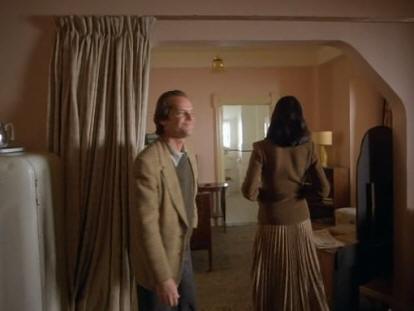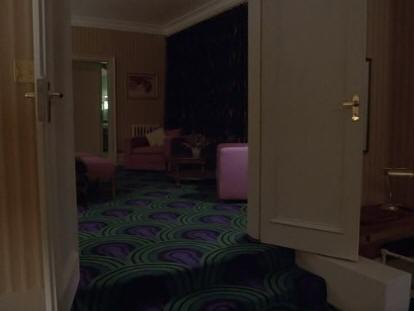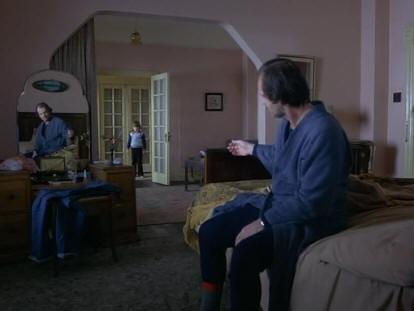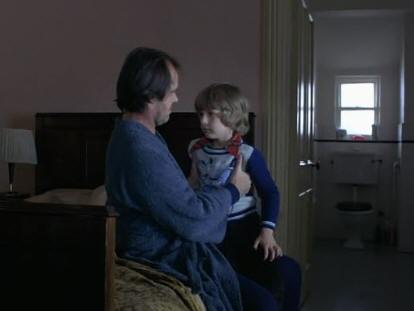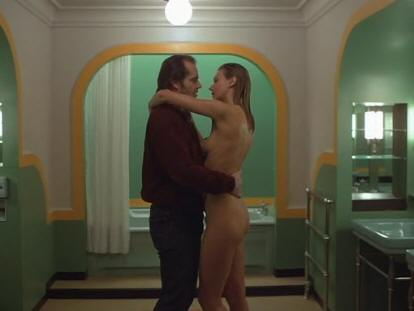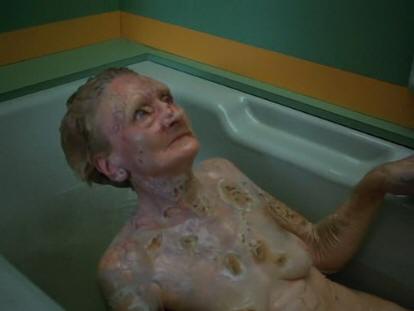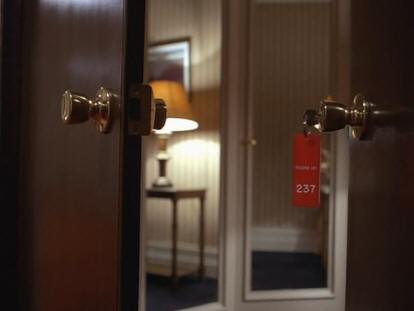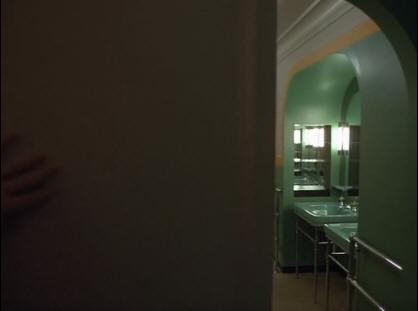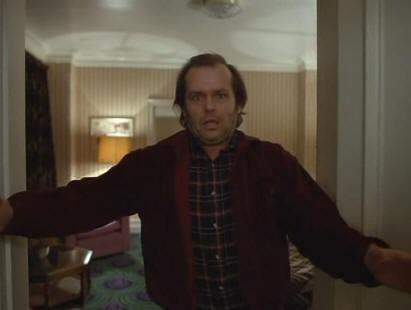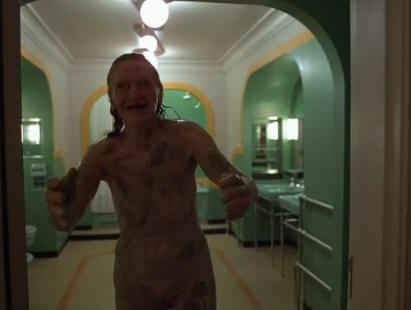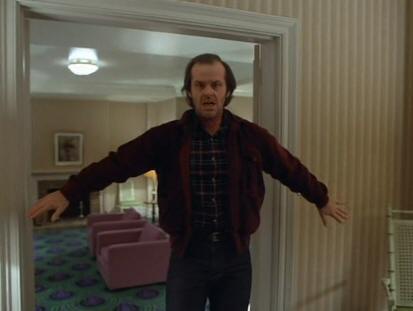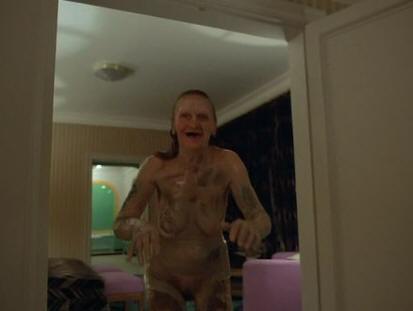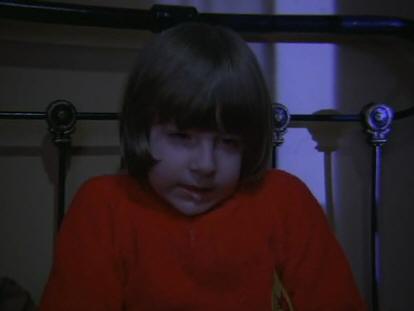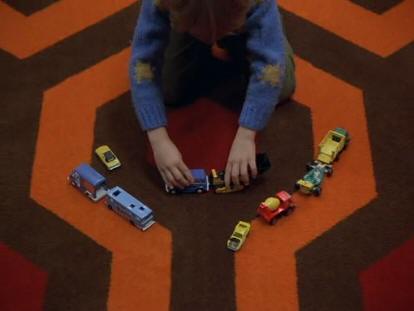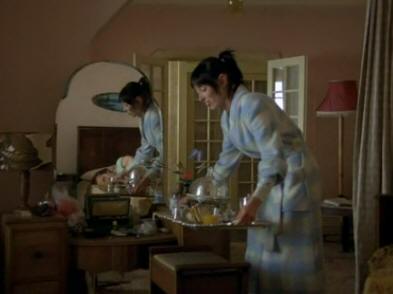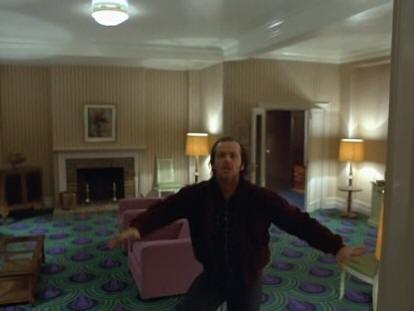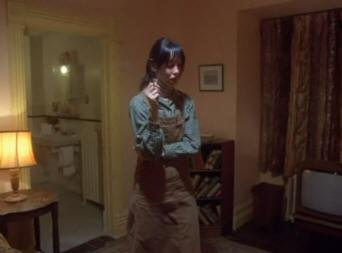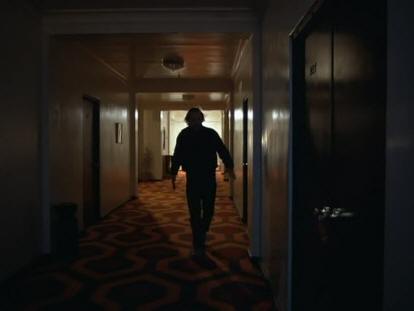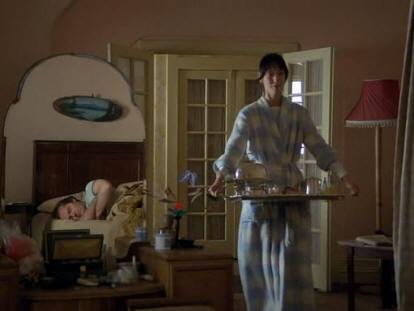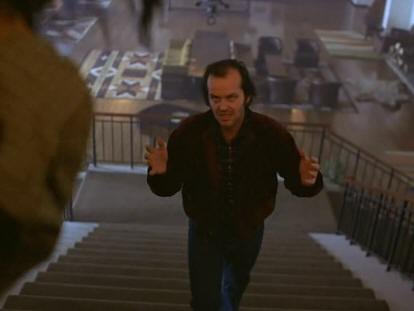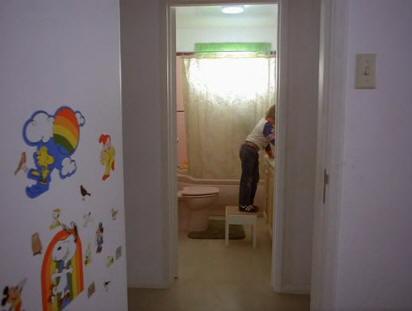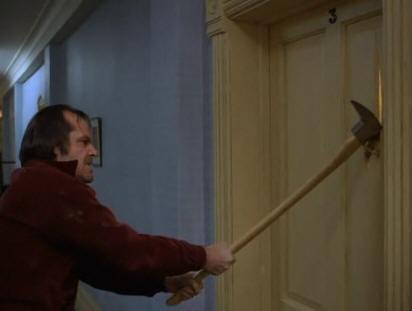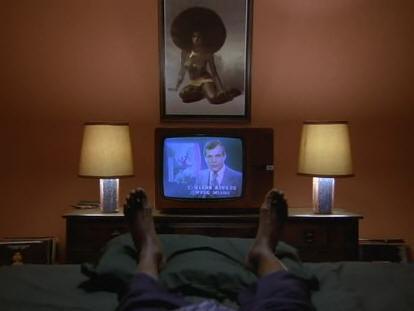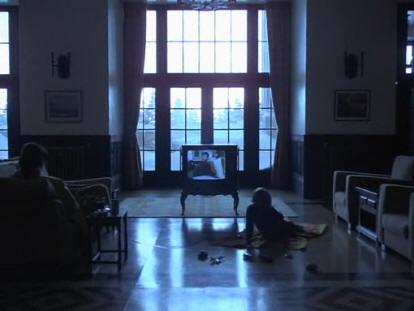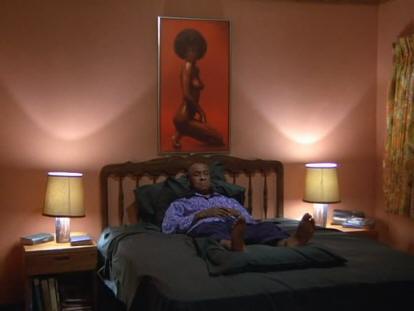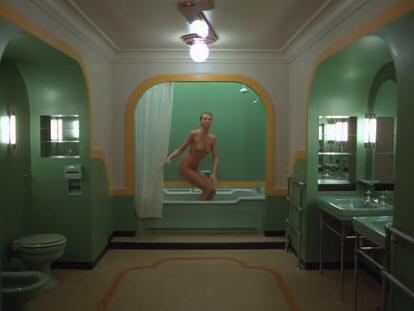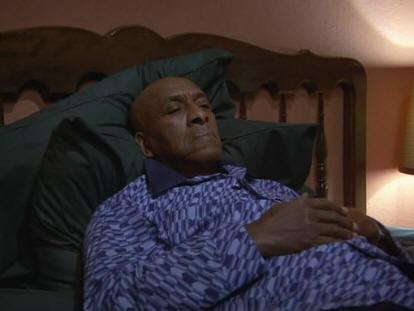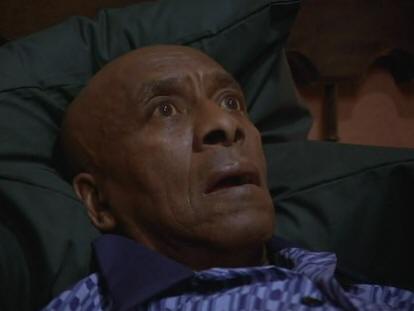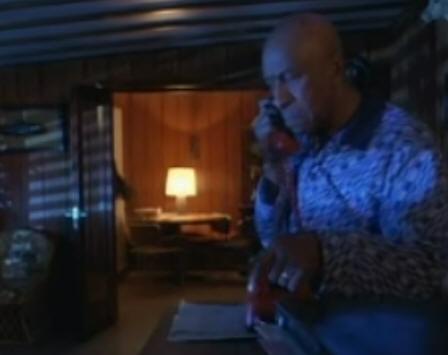CHAPTER EIGHT When Wendy tells Jack about Danny being strangled by a crazy woman, Jack asks her “Which room was it?” and the scene ends. The question “Which room was it?” is important because cross-symbolism between room locations is absolutely essential to uncovering The Shining’s hidden meanings. The room 237 scene is the longest, most complex and most psychologically intense of Danny’s psychic episodes. It is a dream sequence that reveals the fundamental subconscious trauma that is the root of all his psychic visions. But to understand room 237 in detail we first need to pay close attention to a different scene – one that is normally disregarded as uninteresting. In the lobby Danny asks his mother if he can go get his fire engine from his bedroom. His Mother makes him promise not to wake Jack up, but when Danny enters the apartment he finds Jack sat on the bed, looking tired and miserable. Jack gestures for Danny to sit on his knee and Danny approaches with a look of hesitant obedience. A strange conversation then takes place that starts off like a perfectly normal expression of fatherly love, but then Jack makes his weird comment about staying in the hotel “forever and ever”, just as the twins had. Danny then expresses fear of Jack and asks for assurance. Jack reassures Danny that he would never hurt him and the scene ends abruptly with a sudden jolt in the musical score. To accompany the scene Kubrick chose Bela Bartok’s Music for Strings, Percussion and Celesta. This is one of the saddest and most depressing pieces of music I’ve ever heard and is totally at odds with the dialogue. So what’s this scene really about? Well, in studying the room 237 scenes in detail I noticed a multitude of parallels with this strange fatherly love scene. The layout of room 237 is very similar to the Torrance apartment. We enter, turn left, pass through a living room then a bedroom and into a bathroom. The slow movement of the camera through room 237 was paralleled when Mr Ullman was showing the Torrance’s around their apartment. Ullman even emphasized the layout, “Living room, bedroom, bathroom.” Jack and Wendy pass through each room, taking a good look around, then enter the bathroom where we see them stood side by side with a mirror on the right wall. This all parallels Jack’s bathroom encounter with a woman in room 237.
Here are some specific parallels between room 237 and the fatherly love scene.
These aesthetic parallels are too frequent and too specific to be accidental, so I’ll now offer an interpretation that makes sense of both these scenes. Room 237 doesn’t exist. Its cartoonish décor, just like the surrounding hallways, is a figment of Danny’s imagination. It’s a symbolic representation of the Torrance apartment manifested in a dream sequence. This is why the rooms have a similar layout. It’s also why we see multiple aesthetic parallels with the fatherly love scene. One of the things that makes this so difficult to figure out is that the acceptance of room 237 as a dream sequence requires a change in the film’s narrative structure. But the answer is actually staring us in the face if we pay enough attention to both scenes. There’s a really bizarre piece of editing. After Jack sees the rotting woman in the mirror he begins staggering out of the room, pursued by the woman with her hands reaching out in a strangling gesture. But this cuts back and forth to the woman lying in the bath tub, slowly sitting up. Remember also that Danny was told by his mother in the lobby not to wake up Jack while getting his fire engine from the bedroom. Have you made the connection yet? Danny was strangled by Jack in the fatherly love scene for having woken him up. The conversation in the fatherly love scene was a false reassurance, and Kubrick ended the scene just as Jack was about to turn nasty. This's why the scene featured melancholy music that ended with a sudden jolt as we shifted to the next scene. It’s also why we are shown the rotting woman rising out of the bath tub – it’s a parallel of Jack being woken up in bed.
As with any severe trauma, Danny would have gone into shock and repressed the painful experience with amnesia. The dream sequences that followed – being summoned into room 237 by a rolling ball, and Jack’s encounter with the rotting woman – were simply trauma induced nightmares that Danny had after the fatherly love scene. In these dreams Danny is reliving his terrifying ordeal of being strangled and laughed at by his father. Victims of trauma have a tendency to try and identify with their abuser. And this is what Danny does as his suppressed memory of the event consciously resurfaces through his dreams. He re-interprets the trauma as if he is his own father and externalizes the identity of his abuser as a witch-like fairy tale figure. The transformation of the naked woman from beauty to ugliness, which he sees in the bathroom mirror, is a parallel of his father’s sudden mood switch from loving reassurance to violent aggression. The scenes of Danny entering room 237 and Jack walking through to encounter the woman in the bathroom both begin with the exact same shot of the apartment door slightly open with the 237 key hanging from the lock.
It’s interesting that the camera moves toward the mirrors just inside the door when Danny enters, only to fade to a different scene, because when we eventually see the inside of the room we initially don’t know exactly whose point of view we’re experiencing, so the question begs to be asked, "Whose reflection were we about to see in the mirrored doors just inside room 237?" It’s not until after a hand pushes open the bathroom door that we cut to a shot of Jack looking petrified. So the mirrored doors inside the room 237 entrance are a hint of the viewers obscure identity. The cross symbology between doors and mirrors comes powerfully into play in the room 237 scene. The action of a hand slowly pushing open the bathroom door is mirrored in slow motion by the action of the naked woman pushing aside the shower curtain.
After we see the rotting woman in the bathroom mirror, Kubrick then shows us two shots of Jack stepping backward through doorways - the bathroom then the bedroom. Each of these shots flips to a reverse angle in which the rotting woman is shown passing through the same doorway. If we take into account the film's repeated cross symbology between doors and mirrors then these shots of Jack and the rotting woman reveal themselves to be reflections - further demonstrating that the ghostly apparition is a dream manifestation of Jack himself. This may seem like an interpretational stretch, but pay close attention to the shots. Kubrick was very specific in using doorways to frame each character.
Another important connection is that the close ups of Danny trembling in his bed show him with a creepy facial expression very similar to the woman in the bath tub.
So as well as revealing that it was Jack being woken that caused him to strangle Danny, the woman rising out of the tub may also represent Danny himself waking up from his amnesia. From this scene onwards Danny's behaviour changes radically - a subject we'll explore in more detail toward the end of this analysis. Virtually every detail of these scenes fits with the aforementioned alterations to the story structure.
This trauma-induced nightmare concept also explains why Jack returns from room 237 completely composed and claiming to have found nothing. Wendy even tells him at this point that Danny is “still asleep”, yet another indicator that room 237 was a dream sequence . Jack probably never even went into room 237 in the first place and just told Wendy that the door was open and the lights were on to make Danny’s story more convincing. Danny may have even made up the story of the crazy woman because he was afraid of causing a violent fight between his parents. Kubrick went all out to bombard the viewer with subliminal connections between room 237 and the Torrance apartment. Watch Wendy carrying the breakfast tray toward Jack in the bedroom, a foreshadow of the rotting woman stiffly approaching in a strangle gesture.
And then there’s Jack creeping toward Wendy up the Colorado Lounge stairway with a grin and his hands reaching out to grab her.
Another bathroom scene occurs in the film near the start. Danny is talking to himself in a mirror, once again on the right wall, as the camera creeps slowly forward. The shower curtain is pulled across even though there’s no one in the shower, a foreshadowing of the room 237 shower curtain. Both scenes even feature the same music. And the cartoon stickers on Danny’s door are quite suggestive of the room 237 décor. Mickey Mouse is seen in his sorcerer’s outfit in the lower left corner, gesturing toward the bathroom. And the rainbow sticker could be a hint of the cartoon-inspired design of the room 237 carpets, which seem to feature a pattern of overlapping purple rainbows.
Another detail I’d like to mention that possibly cross symbolizes the Torrance apartment with room 237 is that in the book the haunted room was numbered 217, but in the film it was changed to 237. Kubrick said in interviews that the number change was purely because the Timberline Lodge Hotel, which the Overlook exteriors were based upon, has a room numbered 217 and they didn’t want the film to scare future customers away from that room. Being that Timberline didn’t have a room 237, Kubrick changed the 1 to a 3 and everybody was happy. Out of curiosity I checked up on the Timberline Lodge and found that it has only 70 rooms, so I emailed them and asked if they have ever had a room numbered 217. It turned out that they do despite there only being 70 rooms. So it sounded like Stanley was just being straight up about the matter. However, then I noticed that the Torrance apartment is number 3 – the same number that Kubrick inserted into the 217 number to keep the Timberline Lodge owners happy. Co-incidence perhaps, but considering all the other subliminal connections between the two rooms, maybe not.
A factor that remains to be explained about the whole room 237 scene is the fact that the sequence begins with Halloran watching tv in his bedroom and having a shining vision. How can room 237 be a dream sequence if Halloran sees it? There are several details of Halloran’s portion of the scene that suggest something else is going on. Firstly, the scene begins with a shot that zooms out from a tv screen. This also happened when Danny asked his mother if he could fetch his toy fire engine from his bedroom.
So instantly we’ve found a parallel. Then there’s the visual symmetry of the shot. There are lit lamps and stacks of records on both sides of the tv, Halloran’s feet are positioned symmetrically, and the framed picture on the wall is directly centre screen. The composition of the shot is symbolically mirrored along the vertical axis of the screen. When we switch to a third person view of Halloran we again find symmetry in the set arrangement. There are lit lamps on both sides of the bed and again a framed picture perfectly centred on the wall above Halloran’s head.
The overall impression so far is one of duality. But even more interesting is the content of the framed pictures. They both feature naked black women who are posed in near identical positions to the woman in the bath tub. Obviously there’s some sort of character crossover going on.
Then there’s the fact that Halloran is falling asleep just before his fearful vision kicks in, suggesting a dream.
When he begins to shake with fear his eyes look slightly upward from the tv, as if the woman in the framed picture has come to life and transformed into something terrifying.
A detail that supports the idea of his framed pictures of women coming to life is that in the wide shot the bottom of the red picture is almost touching the headboard, but in the next close up of Halloran it is gone.
Once he begins seeing the vision that he is supposedly sharing with Danny, we cut to room 237 and we don’t see his face again for the rest of the scene. My interpretation is that the shots of Halloran in his bedroom are part of Danny’s dream sequence. Notice that we later see three separate scenes of Halloran making phone calls from his apartment. The decor - wooden walls and floorboards - doesn't look much like it did in his bedroom sequence.
In fact, Halloran looks calm and composed, just like Jack did after his room 237 non-event. Halloran didn’t have a shared psychic vision with Danny because there was no psychic vision. It was just Danny dreaming. Halloran’s reason for travelling to the Overlook is revealed in his conversation with Larry Durkin, “We’ve got a very serious problem with the people who’re taking care of the place. They turned out to be completely unreliable assholes. Ullman phoned me last night and I’m supposed to go up there and find out if they have to be replaced.” This is a typical hidden narrative device on Kubrick’s part. In the surface narrative Halloran is lying to Durkin, but in the hidden narrative he is simply saying things how they are. The reasons why Ullman would choose to send Halloran on this trip to the Overlook are an entirely different matter, which we’ll return to later. Another supporting detail for the dream narrative is that Halloran spoke to Danny about having conversations with his Grandmother without ever opening their mouths. This appears to have had an aesthetic effect on Danny’s dream sequence in that there is no conversation with the woman in the bathroom and that she turns into an old woman – a grandmother figure. The room 237 sequence is richly symbolic and multilayered, but the trauma-induced dream interpretation makes sense of virtually every detail. Danny’s shining visions are nothing more than the unconscious manifestations of childhood anxiety and trauma within a violently dysfunctional family unit.
So far I’ve only explained the supposedly supernatural events of the film in terms of Danny’s dream sequences. This has revealed the hidden narrative of room 237, but there’s still the subject of the twin girls, plus a batch of other ghostly apparitions. These will all be covered in subsequent chapters. But now that we’ve uncovered the unpleasant truth about who strangled Danny, it’s time to explore the mind of Jack Torrance.
|
